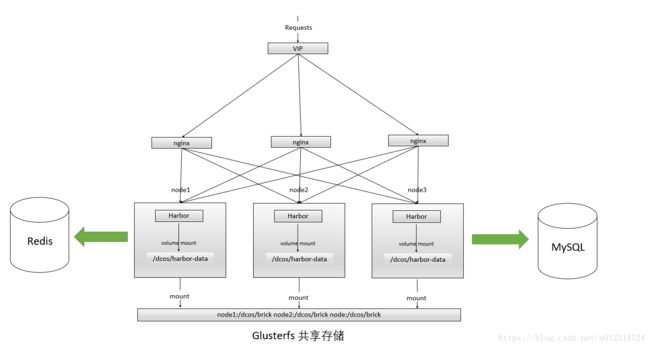在Kubernetes集群上部署高可用Harbor镜像仓库
一、实验环境
harbor的工作节点
10.142.71.120 paasm1
10.142.71.121 paasm2
10.142.71.123 paashar
操作系统:CentOS Linux release 7.2.1511 (Core)
Harbor版本: v1.2.0
GlusterFS: 4.1
redis:4.9.105
docker版本与docker-compose的版本
# docker version
Client:
Version: 1.12.3
API version: 1.24
Go version: go1.6.3
Git commit: 6b644ec
Built:
OS/Arch: linux/amd64
Server:
Version: 1.12.3
API version: 1.24
Go version: go1.6.3
Git commit: 6b644ec
Built:
OS/Arch: linux/amd64
# docker-compose -v
docker-compose version 1.13.0, build 1719ceb
二、方案思路
- MySQL多个实例无法共享一份mysql数据文件,所以考虑将harbor连接的mysql放到外面来。
- 利用GlusterFS对registry中存储的镜像数据进行实时同步。
- 利用keepalived实现虚拟IP,nginx 做负载均衡,以此实现harbor的高可用。
- 利用redis做共享存储
三、部署MySQL
# vi mysql-harbor.yaml
apiVersion: v1
kind: Service
metadata:
name: mysql-harbor
namespace: kube-system
labels:
app: mysql-harbor
spec:
type: NodePort
ports:
- name: mysql
port: 3306
protocol: TCP
targetPort: 3306
nodePort: 32089
selector:
app: mysql-harbor
---
apiVersion: extensions/v1beta1
kind: Deployment
metadata:
name: mysql-harbor
namespace: kube-system
labels:
app: mysql-harbor
spec:
strategy:
type: Recreate
template:
metadata:
labels:
app: mysql-harbor
spec:
containers:
- command:
- docker-entrypoint.sh
- mysqld
- --character-set-server=utf8mb4
- --collation-server=utf8mb4_unicode_ci
image: hub.cmss.com:5000/vmware/harbor-db:v1.2.0
imagePullPolicy: IfNotPresent
name: mysql-harbor
env:
- name: MYSQL_ROOT_PASSWORD
value: "123456"
ports:
- containerPort: 3306
name: mysql-harbor
volumeMounts:
- name: mysql-storage
mountPath: /var/lib/mysql
volumes:
- name: mysql-storage
hostPath:
path: "/dcos/mysql"
nodeSelector:
kubernetes.io/hostname: nodeName
# kubectl apply -f mysql-harbor.yaml
四、 部署GlusterFS
1、下载地址
https://buildlogs.centos.org/centos/7/storage/x86_64/gluster-4.1/
2、所需的RPM安装包
glusterfs-4.1.0-0.1.rc0.el7.x86_64.rpm
glusterfs-api-4.1.0-0.1.rc0.el7.x86_64.rpm
glusterfs-cli-4.1.0-0.1.rc0.el7.x86_64.rpm
glusterfs-fuse-4.1.0-0.1.rc0.el7.x86_64.rpm
glusterfs-libs-4.1.0-0.1.rc0.el7.x86_64.rpm
glusterfs-server-4.1.0-0.1.rc0.el7.x86_64.rpm
glusterfs-client-xlators-4.1.0-0.1.rc0.el7.x86_64.rpm
userspace-rcu-0.10.0-3.el7.x86_64.rpm
3、软件安装
# yum -y install userspace-rcu-0.10.0-3.el7.x86_64.rpm
# yum -y install glusterfs-*
4、启动服务
# systemctl start glusterd.service
# systemctl enable glusterd.service
5、添加GlusterFS节点
# gluster peer probe paasm1
# gluster peer probe paasm2
# gluster peer probe paasher
查看节点状态
# gluster peer status
Number of Peers: 2
Hostname: paasm2
Uuid: 9eeadb95-650e-4dd2-8901-83afaf153cb4
State: Peer in Cluster (Connected)
Hostname: paashar
Uuid: 620ce509-b5c5-4118-a866-0a9385dc47a1
State: Peer in Cluster (Connected)
不显示自身
6、创建分布复制卷
gluster volume create har-val replica 3 paasm1:/dcos/brick paasm2:/dcos/brick paashar:/dcos/brick
三个节点所以副本是3
/启/停/删除卷
# gluster volume start har-val
# gluster volume stop har-val
# gluster volume delete har-val
查看所有卷
# gluster volume list
har-val
查看卷信息
# gluster volume status har-val
Status of volume: har-val
Gluster process TCP Port RDMA Port Online Pid
------------------------------------------------------------------------------
Brick paasm1:/dcos/brick 49152 0 Y 9639
Brick paasm2:/dcos/brick 49152 0 Y 26666
Brick paashar:/dcos/brick 49152 0 Y 5963
Self-heal Daemon on localhost N/A N/A Y 9662
Self-heal Daemon on paashar N/A N/A Y 5953
Self-heal Daemon on paasm2 N/A N/A Y 26689
Task Status of Volume har-val
------------------------------------------------------------------------------
There are no active volume tasks
扩展收缩卷
# gluster volume add-brick har-val [strip|repli ] brick1...
# gluster volume remove-brick har-val [repl ] brick1...
扩展或收缩卷时,也要按照卷的类型,加入或减少的brick个数必须满足相应的要求。
迁移卷(替换)
volume replace-brick {commit force}
7、glusterfs方式挂载(每个节点)
挂载
# mount -t glusterfs paasm1:har-val /dcos/harbor-data/
# echo "paasm1:har-val /dcos/harbor-data/ glusterfs defaults 0 0" >> /etc/fstab
# mount -a
文档
https://gluster.readthedocs.io/en/latest/
五、部署redis
# docker pull redis:5.0-rc5-alpine3.8 // 官方镜像
1. 创建glusterfs存储
gluster volume create redis-vol-0 replica 3 paasm1:/dcos/redis-brick/pv0 paasm2:/dcos/redis-brick/pv0 paashar:/dcos/redis-brick/pv0;
gluster volume start redis-vol-0;
2. 创建GlusterFS端点定义
# vi glusterfs-endpoints.yml
---
kind: Endpoints
apiVersion: v1
metadata:
name: glusterfs-cluster
namespace: kube-system
subsets:
- addresses:
- ip: 10.142.71.120
ports:
- port: 7096
- addresses:
- ip: 10.142.71.121
ports:
- port: 7096
- addresses:
- ip: 10.142.71.123
ports:
- port: 7096
# kubectl apply -f glusterfs-endpoints.yml
3. 配置 service
# vi glusterfs-service.yml
---
kind: Service
apiVersion: v1
metadata:
name: glusterfs-cluster
namespace: kube-system
spec:
ports:
- port: 7096
# kubectl apply -f glusterfs-service.yml
4. 创建PV
# vi glusterfs-pv.yml
apiVersion: v1
kind: PersistentVolume
metadata:
name: pv000
namespace: kube-system
spec:
capacity:
storage: 2Gi
accessModes:
- ReadWriteMany
glusterfs:
endpoints: "glusterfs-cluster"
path: "redis-vol-0"
readOnly: false
# kubectl apply -f glusterfs-pv.yml
5. 创建PVC
# vi glusterfs-pvc.yml
apiVersion: v1
kind: PersistentVolumeClaim
metadata:
name: pvc000
namespace: kube-system
spec:
accessModes:
- ReadWriteMany
resources:
requests:
storage: 2Gi
# kubectl apply -f glusterfs-pvc.yml
6. 创建redis
# vi redis.yml
apiVersion: v1
kind: Service
metadata:
name: redis
namespace: kube-system
labels:
name: redis
spec:
selector:
name: redis
ports:
- port: 6379
targetPort: 6379
---
apiVersion: v1
kind: ReplicationController
metadata:
name: redis
namespace: kube-system
labels:
name: redis
spec:
replicas: 1
selector:
name: redis
template:
metadata:
labels:
name: redis
spec:
containers:
- name: redis
image: hub.cmss.com:5000/registry.paas/library/redis:5.0
command:
- "redis-server"
args:
- "--protected-mode"
- "no"
- "--appendonly"
- "yes"
- "--appendfsync"
- "always"
resources:
requests:
cpu: "100m"
memory: "100Mi"
ports:
- containerPort: 6379
volumeMounts:
- name: data
mountPath: /data/
volumes:
- name: data
persistentVolumeClaim:
claimName: pvc000
tolerations:
- effect: NoSchedule
operator: Exists
# kubectl apply -f redis.yml
查看服务
# kubectl get svc -n kube-system |grep redis
redis ClusterIP 10.233.2.253 6379/TCP 16h
此时可以通过 10.233.2.253:6379访问redis
六、部署Harbor
1. 修改harbor的配置文件
- common/templates/adminserver/env:
MYSQL_HOST= # 由于mysql是nodePort形式,ip可以是集群中任一主机ip
MYSQL_PORT=32089 # 第三步中mysql的Service中定义的nodePort
RESET=true # 如果之前部署过,不设true不会生效
- common/templates/ui/env:
_REDIS_URL=10.233.2.253:6379,100,,0
- docker-compose.yml:
删除mysql相关部分
mysql:
image: vmware/harbor-db:v1.2.0
container_name: harbor-db
restart: always
volumes:
- /data/database:/var/lib/mysql:z
networks:
- harbor
env_file:
- ./common/config/db/env
depends_on:
- log
logging:
driver: "syslog"
options:
syslog-address: "tcp://127.0.0.1:1514"
tag: "mysql"
及proxy下的depends_on里面的- mysql部分。
修改proxy对外暴露端口为81
ports:
- 81:80
2. 修改镜像存储路径
- /data/registry:/storage:z 修改为 - /dcos/harbor-data/registry:/storage:z
3. 安装
# ./install.sh --with-clair
七、部署keepalived
# yum install keepalived -y
选定一台harbor主机作为优先级比较高的master,另一台作为优先级比较低的master。
1. 修改配置文件 /etc/keepalived/keepalived.conf:
! Configuration File for keepalived
global_defs {
notification_email {
[email protected]
[email protected]
[email protected]
}
notification_email_from [email protected]
smtp_server 192.168.200.1 # SMTP服务器地址
smtp_connect_timeout 30
router_id LVS_DEVEL
}
vrrp_script chk_ngx_port {
script "/etc/harbor_chk.sh" # harbor 的check脚本
interval 2
weight -20
}
vrrp_instance VI_1 {
state MASTER
interface eth0 # 网卡名称
virtual_router_id 51
priority 100 # 主节点写100,从节点写99
advert_int 2
authentication {
auth_type PASS
auth_pass 1111
}
virtual_ipaddress {
192.168.200.16 # vip地址
}
}
/etc/harbor_chk.sh脚本的具体内容如下:
#!/bin/bash
status=`curl -s -o /dev/null -w "%{http_code}" http://127.0.0.1/api/repositories/top`
if [ $status == 200 ]; then
exit 0
else
exit 1
fi
# systemctl restart keepalived
# systemctl enable keepalived
八、 部署nginx
1. 编写配置文件
# vi /etc/har-nginx/nginx.conf
error_log stderr notice;
worker_processes auto;
events {
multi_accept on;
use epoll;
worker_connections 1024;
}
stream {
upstream har_server {
least_conn;
server 10.142.71.123:81 max_fails=0 fail_timeout=10s;
server 10.142.71.121:81 max_fails=0 fail_timeout=10s;
}
server {
listen 80;
proxy_pass har_server;
proxy_timeout 1m;
proxy_connect_timeout 1s;
}
}
2. 启动nginx
docker run -d --name har-nginx --restart=always -v /etc/har-nginx/:/etc/nginx/ --net=host registry.paas/library/nginx:1.11.4-alpine

